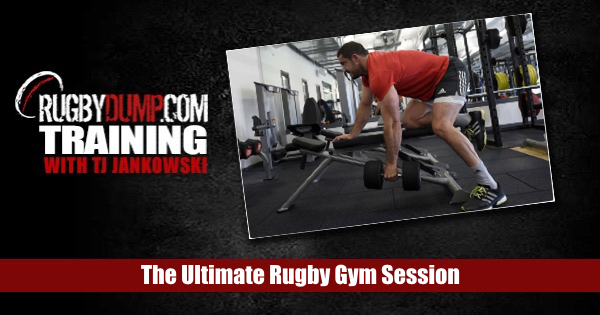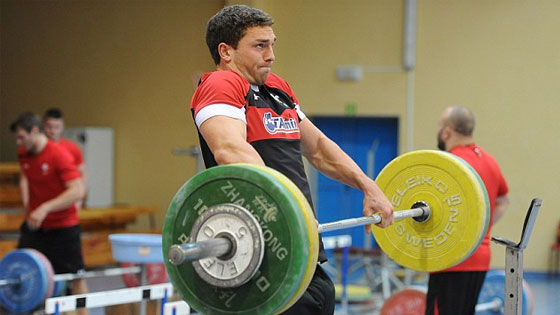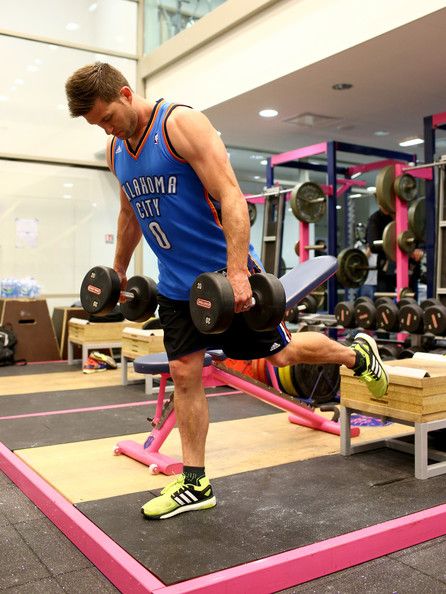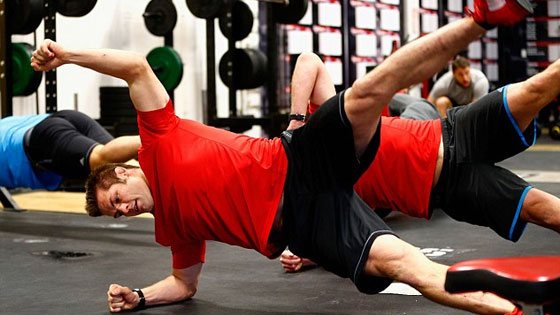
Ever walk into a gym and just have no idea of what to do? Sometimes even though you know what movements you should do you just don’t know how to structure them to create an effective training session. This week Rugbydump Strength Coach TJ Jankowski shows us a cheat sheet on how to create the perfect rugby gym session.
Previously I have written on Rugbydump about recommended movements. These are the pieces of the puzzle that is your rugby strength and conditioning program.
It would be easy to just randomly throw these together and do whatever we feel like each day. But as you’ll probably know, there’s more to it than that. This is not to say that every gym session ever is going to be structured this way, this is perhaps the simplest but also by far the most efficient way of laying out a session.
Getting some of these in the wrong order can lead to a reduced training effect, meaning that some of your progress will be left on the gym floor simply as a result of ordering your movements wrong.
There are times in a program that you’ll not use this structure, in fact if you need to you’ll come far away from it, but for most of you this is what a rugby gym session should look like.
Pre-workout
A quick note to say that the ultimate gym session will require you to do everything right in the build up to the session itself.
This includes sleep and recovery as well getting in good fuel before getting to the gym.
Warm Up / Mobility
Rather than just waste time on a cardio machine, I like to have athletes do some active mobility work as part of their warm up. This way we are warming the body ready for the session, but also getting in quality movement work that will help us become more mobile/flexible in the future.
This will also include activation drills to “engage” muscle groups that will be needed later. A good example drill would be glute bridges and multi-direction hops.
Explosive work
This is where you’ll want to do jumps, speed work and explosive medicine ball work. Doing explosive work requires maximum velocity, this means that you’re body needs to be fresh in order to do it – otherwise you’re not working power, you’re just working strength a bit faster. So if you do explosive work later in the session you won’t be getting the maximum benefit.
This is also a good time to get in any rugby-specific work (e.g. footwork drills with a ball) because this will build power in the correct movement pattern that you need for the games. 1-3 movements with 4-8 sets of 3-5 reps will be good here.
Explosive lift

Explosive lifts are a little bit heavier than the explosive work discussed above. Here we’re looking at things like olympic lifts, weighted jumps, even bench press throws or explosive barbell returns. Any dynamic lift would be here, the beauty of all this explosive work you’re getting in is that science has show that this stuff will actually get you primed and ready to lift heavy far better than any traditional warm up.
Look to do 1 or 2 movements with around 3-5 sets of 1-5 reps.
Heavy Compound Lift(s)
Ok, now your traditional gym work starts. Squats, deadlifts, pressing variations and heavy rows or pulls are all great to build some quality strength, which is what you want to do here. Ideally look at some lower body work to begin with as it’s more taxing so is best done fresh, but if you’ve got a plan in mind that doesn’t involve heavy lower body work then don’t worry.
Start at a weight you were using for the explosive lifts or build up from even lighter, don’t just pack on the plates and start your first set.
Depending on what you have coming up you can do 1-4 heavy movements with sets of 3-7 and reps of 3-5.
Uni-Lateral movements

Uni-lateral movements are incredibly important for building the bridge between strength/power gained in the gym and those some attributes being shown on the pitch. Single-leg and single-arm variations of movements should be a part of all athletic gym programs.
Whilst you can perform real heavy versions of these lifts and slot them into the category above, it is often better to focus on a slightly lighter weight so that you focus on building the stabilizers and leave the strength work to more simple variations.
This type of work is excellent for building quality athletic muscle as well as help put you in the best scenario for avoiding injuries.
2-4 difference movements will work well here with you performing anywhere between 6-15 reps and 2-5 sets.
Lighter, Accessory Work
This is where you can focus on building the muscle and working movements that will help prevent injuries. There will usually be some muscles that have been missed by the above work, here you can get in some extra work to help prevent or fix any imbalances that you may have. This is also where bicep curls go.
To be honest, some stages of a program will have none of this but you could still work up to 4 different movements, using 2-4 sets of 8-15 reps.
Core Work

We put core work pretty much last in a program because we need the core to be fresh for most of the above movements. Doing heavy core work before doing squats for example could really lead to a drop in performance, or even worse an injury (this is NOT to say that you can’t do any activation drills before, it’s just something to bear in mind).
Look at the different torso variations I listed HERE and get to work. 1-4 different movements will work well, but sets and reps will differ greatly depending on the exercise.
Non-specific Conditioning work
If you have any conditioning work that doesn’t involve rugby-specific work (sprinting, tackling etc.) then it should go here at the end. Bikes, rowing machines, small circuits will all help bring up the conditioning after you’ve already got the main strength/power benefit from the session.
The reason it might not be good to do rugby-specific work is due to the nature of the skill, it’s not wise to practice such specific skills when you’re already fatigued from the work above. You can still train the heart to a great affect which can really lead to an increase in performance (read more here)
Cool Down
Another thing that way too many guys miss in their program. Take a few minutes to statically stretch the muscles and unwind after a session. This should help stop stiffness and soreness in coming days so that you can continue to train/play hard.
It’s also important to take a few minutes to mentally unwind from the session too. Training is an extremely high-stress activity and in order to recovery you need to really begin to pull that stress back down. A cool down can really help with this.
Bringing It Together.
So now that you have all the framework of an amazing session, you just need to be aware of a few things.
Don’t just mindlessly work the maximum amount on everything, your session should last around 60-90 minutes at the most. Anything longer and you will be too fatigued to get much benefit (even if you think you’re fine).
Choose one or two areas of emphasis, they should end up taking up a large chunk of the session. If you need help coming up with ideas, feel free to comment below or get in touch with me any other way.
About TJ JankowskiTJ Jankowski is a former international rugby player for Poland rugby, who achieved their highest world ranking of 23 whilst he was part of the team. |
|

Sign In